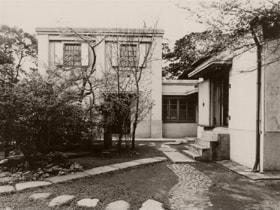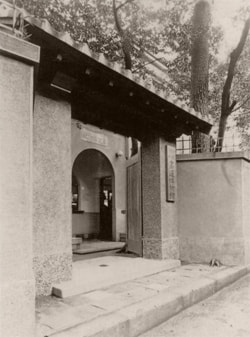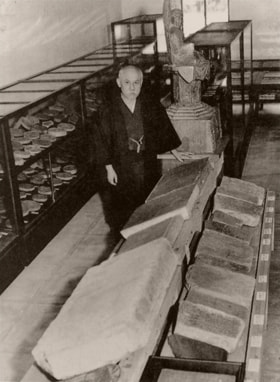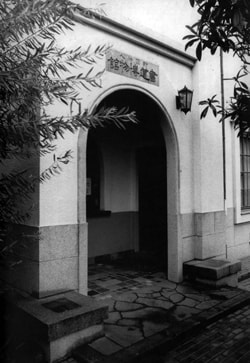
Main building of Taito City Calligraphy Museum (A historic spot of the Metropolis of Tokyo)

Main building and garden of past days
Q : As for calligraphy, did he belong to any group?
Nabeshima: Fusetsu and his fellows made a study group of calligraphy and displayed their works at some exhibitions. He did such club-like activities, but did not stick to any group. He once said, "Calligraphy is my hobby," so he did it in his own way without belonging to any group. He also lent his collections to exhibitions held by a variety of calligraphy groups, and helped organize special exhibitions of calligraphy. As for a study group of calligraphy, he and Hekigoto Kawahigashi and others formed "Ryumin-kai," a kind of private calligraphy group. I think they engaged in the activity with a flexible stance with which they wrote what they liked and did what they liked.
Q : Did Fusetsu not only collect calligraphy but also write calligraphy? Did he also compose Chinese poems?
Fusetsu wrote a lot of calligraphy. He also composed some Chinese poems. After all, his calligraphy's theme was Chinese poems written in the Tang period. He wrote on the theme of famous poems while copying Chinese classics, such as rubbed copies. Also, he imitated historical masterpieces. (Leading to the bottom)
Fusetsu lived in Negishi because he wanted to stay near Shiki. Shiki had lived in a house where the present "Shiki-an" is located, so it was close enough for Fusetsu to walk to Shiki's house when Fusetsu lived in Nakanegishi. Fusetsu moved several times within Negishi. He settled in the existing house in 1915. At this time, although Shiki had already passed away, Fusetsu's deep respect for Shiki can be sensed from the fact that Fusetsu lived in a house diagonally across from Shiki's.
Q : Did Calligraphy Museum open in 1936?
Yes, it did. Fusetsu realized the value of Chinese artifacts when he went to China in 1895 during the Sino-Japanese War, and then continued collecting those items throughout his life. In order to store those items, he first built a facility called "Kinseki-kan" in 1933. Of course, he did so for his study, but he also wanted to contribute to society by opening them to the public. With recommendations from people around him, he opened Calligraphy Museum as a foundation in 1936. (Leading to the bottom)
Q : As for calligraphy, did he belong to any group?
Fusetsu and his fellows made a study group of calligraphy and displayed their works at some exhibitions. He did such club-like activities, but did not stick to any group. He once said, "Calligraphy is my hobby," so he did it in his own way without belonging to any group. He also lent his collections to exhibitions held by a variety of calligraphy groups, and helped organize special exhibitions of calligraphy. As for a study group of calligraphy, he and Hekigoto Kawahigashi and others formed "Ryumin-kai," a kind of private calligraphy group. I think they engaged in the activity with a flexible stance with which they wrote what they liked and did what they liked.
Q : Did Fusetsu not only collect calligraphy but also write calligraphy? Did he also compose Chinese poems?
Fusetsu wrote a lot of calligraphy. He also composed some Chinese poems. After all, his calligraphy's theme was Chinese poems written in the Tang period. He wrote on the theme of famous poems while copying Chinese classics, such as rubbed copies. Also, he imitated historical masterpieces.
Q : Calligraphy Museum has enormous collections. How did he collect these items?
In the early Showa Period, collectors were supported by financial conglomerates, such as Mitsui or Sumitomo, or businessmen or financiers collected calligraphy as a hobby. These were main ways of collecting calligraphy. Since Fusetsu was just a calligrapher or painter who did not have a luxurious lifestyle, he collected the items by selling his works, and helped build the museum. Although he made a lot of calligraphy and Japanese-style paintings, the main purpose was to sell them, not to exhibit them. I think he produced many works for a living. His motivation behind his works may be to collect the items.

Calligraphy Museum entrance of past days
Main Building retain the atmosphere the past that was still unchanged by the Great Kanto Earthquake.

Fusetsu Nakamura in front of his collections
Q : Calligraphy Museum has enormous collections. How did he collect these items?
In the early Showa Period, collectors were supported by financial conglomerates, such as Mitsui or Sumitomo, or businessmen or financiers collected calligraphy as a hobby. These were main ways of collecting calligraphy. Since Fusetsu was just a calligrapher or painter who did not have a luxurious lifestyle, he collected the items by selling his works, and helped build the museum. Although he made a lot of calligraphy and Japanese-style paintings, the main purpose was to sell them, not to exhibit them. I think he produced many works for a living. His motivation behind his works may be to collect the items.
Q : Was there any reason he took up residence in Negishi?
Fusetsu first took up residence in Negishi in 1898. The following year, 1899, Fusetsu set up his studio in Nakanegishi. Shiki visited the opening party of Fusetsu's studio even though Shiki was suffering from an illness. Fusetsu's wife wrote in her diary that Shiki rode on a cart pulled by his sister Ritsu and visited the party to offer his congratulations. (continued on top right)
Q : When was the museum placed under the control of Taito City? Was the present-day Fusetsu Nakamura Memorial Hall newly built?
Nabeshima: The museum was placed under the control of Taito City in December 1995. The museum's third director (Hatsuko Nakamura), a granddaughter of Fusetsu, donated the buildings and all the collections to Taito City. In order to open it as a city museum, the preparation work, such as securing safety and allowing wheel-chair access, had been carried out until 2000. The museum opened as Taito City Calligraphy Museum in April 2000. Since the main building of the Fusetsu Nakamura Memorial Hall was designated as a historical relic by the Tokyo Metropolitan Government, it needed to be brought back to the original condition as a principle when repairing it. Also, the colors of coating should be restored to the original. Actually, air conditioners should not have been newly installed. However, if not to do so, a comfortable condition could not be provided to visitors, so air conditioners were equipped. As for other buildings in the grounds, there was a large wooden house when Fusetsu was alive, but it was totally destroyed by fire due to a major air raid in April 1945, and only the museum was left. His collections were saved because they were stored in the museum, but almost all materials relating to the Nakamura family were destroyed by the blaze.(continued in the next page)
Q : Was there any reason he took up residence in Negishi?
Fusetsu first took up residence in Negishi in 1898. The following year, 1899, Fusetsu set up his studio in Nakanegishi. Shiki visited the opening party of Fusetsu's studio even though Shiki was suffering from an illness. Fusetsu's wife wrote in her diary that Shiki rode on a cart pulled by his sister Ritsu and visited the party to offer his congratulations.
Fusetsu lived in Negishi because he wanted to stay near Shiki. Shiki had lived in a house where the present "Shiki-an" is located, so it was close enough for Fusetsu to walk to Shiki's house when Fusetsu lived in Nakanegishi. Fusetsu moved several times within Negishi. He settled in the existing house in 1915. At this time, although Shiki had already passed away, Fusetsu's deep respect for Shiki can be sensed from the fact that Fusetsu lived in a house diagonally across from Shiki's.
Q : Did Calligraphy Museum open in 1936?
Yes, it did. Fusetsu realized the value of Chinese artifacts when he went to China in 1895 during the Sino-Japanese War, and then continued collecting those items throughout his life. In order to store those items, he first built a facility called "Kinseki-kan" in 1933. Of course, he did so for his study, but he also wanted to contribute to society by opening them to the public. With recommendations from people around him, he opened Calligraphy Museum as a foundation in 1936.
Q : When was the museum placed under the control of Taito City? Was the present-day Fusetsu Nakamura Memorial Hall newly built?
The museum was placed under the control of Taito City in December 1995. The museum's third director (Hatsuko Nakamura), a granddaughter of Fusetsu, donated the buildings and all the collections to Taito City. In order to open it as a city museum, the preparation work, such as securing safety and allowing wheel-chair access, had been carried out until 2000. The museum opened as Taito City Calligraphy Museum in April 2000. Since the main building of the Fusetsu Nakamura Memorial Hall was designated as a historical relic by the Tokyo Metropolitan Government, it needed to be brought back to the original condition as a principle when repairing it. Also, the colors of coating should be restored to the original. Actually, air conditioners should not have been newly installed. However, if not to do so, a comfortable condition could not be provided to visitors, so air conditioners were equipped. As for other buildings in the grounds, there was a large wooden house when Fusetsu was alive, but it was totally destroyed by fire due to a major air raid in April 1945, and only the museum was left. His collections were saved because they were stored in the museum, but almost all materials relating to the Nakamura family were destroyed by the blaze.(continued in the next page)

Main building of Taito City Calligraphy Museum ( A historic spot of the Metropolis of Tokyo)

Main building and garden of past days










